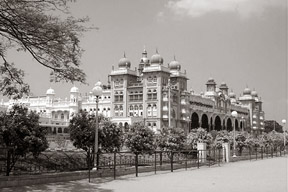|
observer |
|
|
|
|
|
OTHER LINKS |

|

|

|
Mysore Palace:An astounding edificeThe dramatic beauty of the Mysore Palace, located in the heart of the city, whether illuminated or not, takes one's breath away. Also known as the Amba Vilas Palace, it is one of India's largest palaces, its opulence and colour virtually peerless.
The residence of the erstwhile rulers of the Wodeyar dynasty, the splendid structure was constructed in 1911 on the foundations of an old wooden palace that was burnt down in 1897. The exterior of the three-storey structure reflects a healthy combination of Dravidian, Indo-Sarcenic, Oriental and Roman styles of architecture. The five-storey palace tower features beautifully designed square towers, covered at various cardinal points by domes (some of them of ochre colour), as well as turrets, arches and minarets. Designed by the well-known British architect Henry Irwin for the 24th Wodeyar king, and said to be modelled on the Vijayanagar Palace at Chandragiri in Andhra Pradesh, the palace is 245 feet in length and 156 feet in breadth. There is a gold-plated dome about 145 feet from the ground that covers the open courtyard in the centre. The front of the palace has an open balcony supported by massive circular columns, The beautiful carvings, replete with rosewood and ivory inlays, a kaleidoscope of stained glass and mirrors, carved wooden and solid silver doors and mosaic as well as marble floors, are a sight to behold. The intricately carved doors open into stunning, luxuriously decorated rooms. On the ground floor's enclosed courtyard, paintings and portraits, jewellery, royal costumes, musical instruments, children's toys and other items belonging to the Wodeyars are displayed. The upper floor has a small collection of weapons. The palace is a treasure trove of exquisite carvings, artefacts and works of art from all over the world. Entry to the palace is through the Gombe Thotti or the Doll's Pavilion, a gallery of Indian and European sculptures and ceremonial objects. Halfway up is the Elephant Gate, which is the main entrance to the centre of the palace. The gate is decorated with floral designs, and bears the royal insignia, a double-headed eagle. Located north of the gate are dolls dating from the early 19th and 20th centuries, and a ceremonial wooden elephant howdah (a contraption kept on top of the elephants to carry royalty) decorated with 24-carat gold. To the south is the magnificent Kalyana Mandapa (marriage hall), which has a central octagonal gabled ceiling, with tall, slender cast iron pillars wrought at Glasgow (Scotland) and arranged in groups at three of the corners. The central octagon is covered by multicoloured stained glass panes with peacock motifs arranged in geometrical patterns, and features chandeliers from the former Czechoslovakia. The flooring has glittering glazed tiles imported from England, and laid in artistic geometrical patterns. The walls that lead to the Mandapa are lined with oil paintings depicting scenes from Dasara celebrations during the Maharaja's rule. Located on the second floor is the `Diwan-I-am' or Durbar Hall. The hall has an ornate ceiling, a shining floor and many sculptured pillars, which according to legend, are painted with gold. The frescoes in the hall depict eight manifestations of Goddess Shakti, scenes from the Ramayana and the Mahabharata and a painting of Raja Ravi Varma. Also on the second floor is the Diwan-e-Khas (hall for private audience), which has beautifully carved doors and a central nave with a stained glass ceiling that is supported by metallic, bow-shaped beams and bars. The ceiling and the walls have designs painted in blue, red and gold. There are 12 temples built in typical Dravidian style, on the palace premises. Rites are conducted in these temples on special occasions. Since its acquisition by the government, the palace is under the supervision of the Department of Archaeology and Museums and has been converted into a museum. The scion of the Wodeyars, Srikantadatta Narasimharaja Wodeyar, resides in a section of the palace. Its day-to-day affairs are managed by the Mysore Dasara Palace Board. Explains S. Selvakumar, Mysore Deputy Commissioner and Executive Officer of the Board: "We maintain the buildings and the gardens and salaries of the staff, with the money that comes from gate collections. Recently, we replaced broken electric fittings and 80,000 fused bulbs. The gate money is also used to pay for the power that is consumed for the illumination of the palace." (www.hinduonnet.com) |









